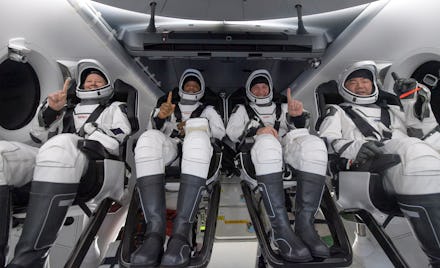NASA is trying to solve the problem of dirty underwear in space

In space, no one can hear you scream. Luckily, no one can smell you, either. Under those pristine, white space suits that we always imagine astronauts in, displaying the utmost poise as they take humanity into the unknown, there are some dirty-ass clothes and underwear that are caked with filth and clinging to stinky bodies.
According to a report from the Associated Press, NASA is desperately seeking answers on how to keep astronauts and their clothes clean, because the waste is getting ridiculous — especially with long-term stays on the International Space Station and possible trips to Mars in the not-too-distant future. The space agency says that the average astronaut needs about 150 pounds worth of clothes with them to keep them covered for an entire year away from Earth. And that's with the space explorers wearing clothes for extended periods, even as they get covered in sweat.
According to AP, astronauts are asked to wear their clothes for as long as they can, until the smell and the gross feeling of building filth just becomes too much. That can happen quicker than you might imagine, as astronauts typically work out for two hours per day in order to counteract the effects of weightlessness, which can result in significant loss of muscle and bone mass. Clothes usually make it about a week before they get labeled as too toxic to continue, at which point astronauts trash the clothes and put on a new outfit, turning the previous fit into space waste.
This has been a long-standing problem for astronauts on extended stays. In an article from 2003, NASA explained that astronauts are asked to keep wearing their clothes because there simply is not much closet space once you get off of Earth. "Plus, when it costs between $5,000 and $10,000 per pound to launch it into space, that becomes some very expensive underwear," the article says. NASA goes on to say that there are functions for dirty clothes, like using items as a makeshift planter — but the most likely outcome for rank space undies is that they get loaded up with the trash and shot out into space, where they burn up in the Earth's atmosphere.
Now, you might be thinking there's an obvious solution here: Just launch a space laundromat. But could you imagine trying to plug quarters into the washer with zero gravity? It'd be a nightmare. Plus, traditional methods like this would take too much water — which is the primary reason that astronauts simply can't wash their clothes. Instead, according to AP, NASA has decided to partner with Tide to run a series of experiments with the goal of making clothes in space washable and reusable.
In the first test run, which is set to make its way into space in December, Tide and NASA will send up a custom-made detergent to see how its enzymes survive in six months of weightlessness. If all goes well, another test run is set for May that will launch stain removal wipes and pens into space — which feels like it is taking the concept of the Tide To Go pen to its logical, if extreme, endpoint.
Additionally, the partners will work on creating a washer and dryer that could operate in space using only the smallest amount of water and detergent. The idea is to keep the amount of resources needed low so that the clothes cleaners can function in an environment where resources like water might not be readily available — say, on the surface of the moon or Mars.
These are the types of small but important little details that have to be accounted for to make space travel possible. Every little thing, no matter how mundane, must be thought through. That said, you have to admit that it's a little funny that some of our brightest minds may also have the dirtiest underwear.